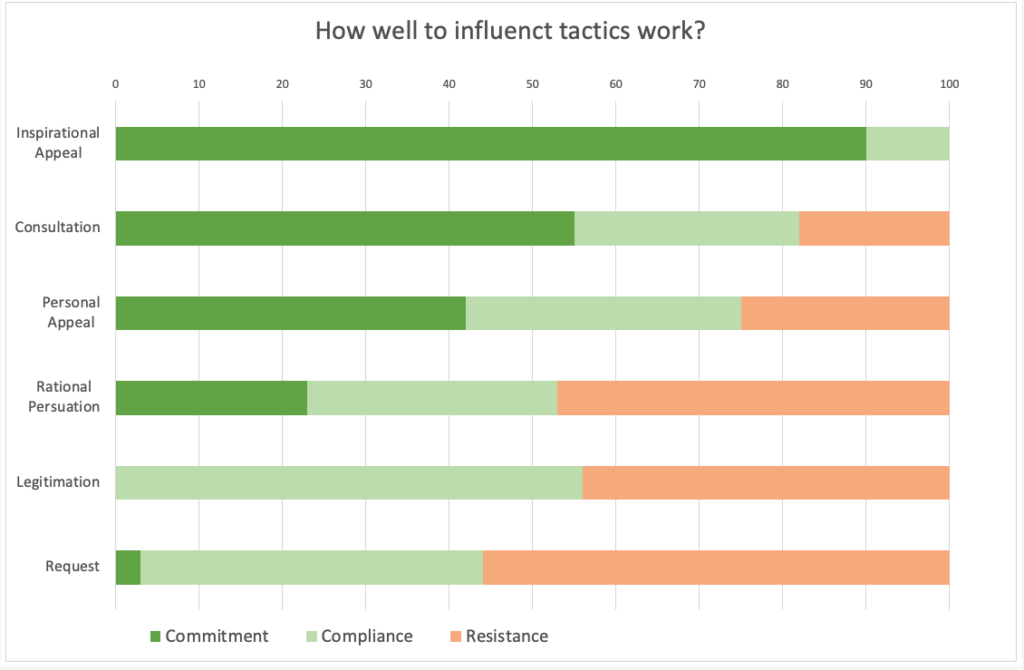The right question?
Should one even try to change others?
Is it legitimate to try to change others?
Here is my personal opinion. There are many situations in which it is worthwhile and absolutely legitimate to influence the behaviour of our fellow human beings so that they behave differently. Especially if the new behaviour has positive consequences for the fellow human being and his environment.
One thing is clear, however. No one likes to be told what to do by someone else.
So the question would have to be posed differently. In this article, I will therefore explore the following question
What can we do to influence the behaviour of others?
It can be about something trivial like getting the colleague or the son to put the used dishes in the dishwasher.
Or about much more important things, such as the implementation of the new strategy or the realisation of an important project.
Now, people’s ability to change is assessed very differently. Some assume that changeability and the ability to learn remain constant throughout life. “Personality isn’t permanent” and the like are among them. Some authors go so far as to claim that an introverted person could change into an extroverted person.
Many personality psychologists and neuroscientists are more sceptical and assume that the basic traits of our personality are formed early on and provide the framework within which changes are possible.
Basically, people do what the unconscious motives and conscious goals anchored in their personality tell them to do – people are predominantly internally controlled.
(Gerhard Roth)
Irritating insights when trying to change fellow human beings
In our private lives, as in our professional lives, we assume that people will change if we give them good reasons to do so.
But the reality is different.
So it can happen that our fellow human beings, be it a colleague, a co-worker or a life partner
(1) does not accept our arguments,
(2) accepts our arguments and promises to change, but does not do so,
(3) changes only temporarily, but then reverts to the previous behaviour.
In the first case, we are irritated to find that our arguments are not followed even though they are highly logical.
The second situation is more difficult to understand, since understanding and acceptance have been shown here.
If we dig deeper, however, we realise that a part of the employee’s conscious ego accepts the arguments, but that other, deeper motives speak against them and the person concerned can only suppress this contradiction for the time of the conversation.
In the third and most difficult case, the arguments presented are fully accepted on a conscious level and the changes are certainly tackled, but the momentum does not last and the fresh energy soon slackens again.
Things come to mind that have been undone for a long time, one must first tidy up the office or the warehouse, one must clarify this or that, or finish this or that thing first.
In the words of Gerhard Roth
“Underlying such behaviour is a deep conflict, often not realised by the person concerned, an inconsistency between the conscious goals and the unconscious motives. The affected person’s conscious ego agrees with everything that is demanded of him in terms of change, but his unconscious ego, or at least an important part of it, does not.”
A consensus between unconscious motives and conscious goals is, however, indispensable for longer-term change.
The unconscious of the person concerned must have time to get used to the challenges associated with the changes.
This takes much longer than the conscious changes in attitude. If one does not do this, the “valley of tears”, in which we simply do not get anywhere, is particularly long and deep.
Here is an illustration with the analogy of an iceberg

What can we do to influence the behaviour of others?
In the book “When Execution is not enough” 9 tactics are presented
Hard tactics
1. Requesting
2. Legitimating
3. Coalition
Soft Tactics
4. Rational persuasion
5. Socialising
6. Personal appeals
7. Exchanging
8. Consultation
9. Inspirational appeals
Ich werde hier auf 5 davon eingehen
Requesting
“This strategy is the quickest, most convenient and therefore most frequently practised by superiors, but also the most ineffective.In most cases, no substantive reasons are given to those affected as to why something is now being done differently, and the personality structure of the employees is not even dealt with superficially: After all, the changes are mandatory and no one can be against them!”
(Roth)
“I want you to finish this report by tomorrow.”
“I expect this tool to be used from now on”.
Legitimating
Here, an attempt is made to legitimise the order by referring to a higher authority.
“The CEO has instructed me to …”
“It is the rule in our company that … ”
Rational persuasion
Here, logical arguments are used to legitimise the request.
For example, the manager plausibly presents the threatening situation, describes the need to adapt to new market conditions and consumer behaviour as a result of globalisation, etc. The disadvantage of this strategy is that the basic needs of the employees are not addressed.
The disadvantage of this strategy is that on the part of the employees the elementary needs are not addressed.
This tactic is therefore not very effective, especially because it is the logic of the boss and not the logic of the employee.
Personal appeals
Here I ask the other person to do me a favour. Personal appeals are more directed at other people and presuppose a certain relationship of trust between the person asking for a favour and the person to be influenced.
Consultation
Here, an attempt is made to involve the other person in determining what needs to be done.
An attempt is made to find a solution to the problem together. The other person’s thoughts, feelings and motives are taken into account.
“In your opinion, what are the advantages and disadvantages of this approach?”
“What solutions do you see how we could address this problem?”
This is a very effective method.
Inspirational Appeal
This strategy is the most difficult. But also the most effective. For me this is the holy grail of influence tactics.
As a leader, I have to be able to assess which personality type I have in front of me: the confident or reliable one, or the fearful or avoidant one, or the brash doer or impulsive one.
I need to know the person’s stress management, their particular merits and demerits.
I need to know whether the person likes to be guided or likes to decide things for themselves.
In particular, I need to recognise the unconscious motives – as far as this is possible to find out – and the conscious goals and identify the resulting reward expectation.
Finally, here is a graphic that shows which tactics work and how.

Next steps
- If you are ready to act, book a 15 minute call to check if we are a good fit.
- If are not ready yet, but found this content useful, sign up to Monday Memo, to be updated when we publish new content.
Cover Photo by Roger Bradshaw on Unsplash
